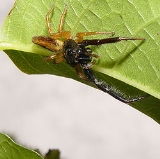
Trite planiceps
Encyclopedia
Trite planiceps is a common jumping spider
endemic to New Zealand
and one of about 150 species of jumping spiders in New Zealand.
) and similar plants. These leaves are typically one to two meters long and 5 to 10 cm wide.
They also change from vision-based courtship in the open to vibratory courtship when mating inside a rolled-up leaf. If an immature female is within about ten days of maturing, the male will live with her for this time and then mate inside the leaf. The two are in physical contact for a while after mating, and communicate using tactile signals. Upon entering a rolled-up leaf, both sexes will tap the leaf surface with the first pair of legs and vibrate their abdomen
.
Juveniles and subadults build flat, tubular silk cocoons with a door at each end inside rolled up leaves. Adult females build a silk platform 50% longer and two to three times wider than their own size before laying up to seven egg batches with 8 to 40 eggs each. Each batch is enclosed in its own silk casing. Males normally do not build nests.
A wide array of behavioral patterns has been observed, among others ritualized male duels.
Jumping spider
The jumping spider family contains more than 500 described genera and about 5,000 described species, making it the largest family of spiders with about 13% of all species. Jumping spiders have some of the best vision among invertebrates and use it in courtship, hunting and navigation...
endemic to New Zealand
New Zealand
New Zealand is an island country in the south-western Pacific Ocean comprising two main landmasses and numerous smaller islands. The country is situated some east of Australia across the Tasman Sea, and roughly south of the Pacific island nations of New Caledonia, Fiji, and Tonga...
and one of about 150 species of jumping spiders in New Zealand.
Description
Males and females range in body length from 6 to 14 mm. In males, the first pair of legs is elongated, and they bear a row of dark hairs above the frontal eyes. Their chelicerae are also more robust.Behavior
While most jumping spider rely mostly on their very acute eyesight, T. planiceps has been shown to seize on prey in the dark, probably by means of vibratory signals. Unlike typical jumping spiders, they do not make nightly web shelters. As T. planiceps lives in low altitudes, this could be an adaptation to cool overcast winters, where they need to survive within the dim recesses of rolled-up leaves of New Zealand flax (Phormium tenaxPhormium tenax
Phormium tenax is an evergreen perennial plant native to New Zealand and Norfolk Island that is an important fibre plant and a popular ornamental plant...
) and similar plants. These leaves are typically one to two meters long and 5 to 10 cm wide.
They also change from vision-based courtship in the open to vibratory courtship when mating inside a rolled-up leaf. If an immature female is within about ten days of maturing, the male will live with her for this time and then mate inside the leaf. The two are in physical contact for a while after mating, and communicate using tactile signals. Upon entering a rolled-up leaf, both sexes will tap the leaf surface with the first pair of legs and vibrate their abdomen
Abdomen
In vertebrates such as mammals the abdomen constitutes the part of the body between the thorax and pelvis. The region enclosed by the abdomen is termed the abdominal cavity...
.
Juveniles and subadults build flat, tubular silk cocoons with a door at each end inside rolled up leaves. Adult females build a silk platform 50% longer and two to three times wider than their own size before laying up to seven egg batches with 8 to 40 eggs each. Each batch is enclosed in its own silk casing. Males normally do not build nests.
A wide array of behavioral patterns has been observed, among others ritualized male duels.
External links
- Jumping spiders (family Salticidae), Museum of New Zealand Te Papa Tongarewa
- Salticidae.org: Diagnostic drawings + photographs
- Frontal photograph

